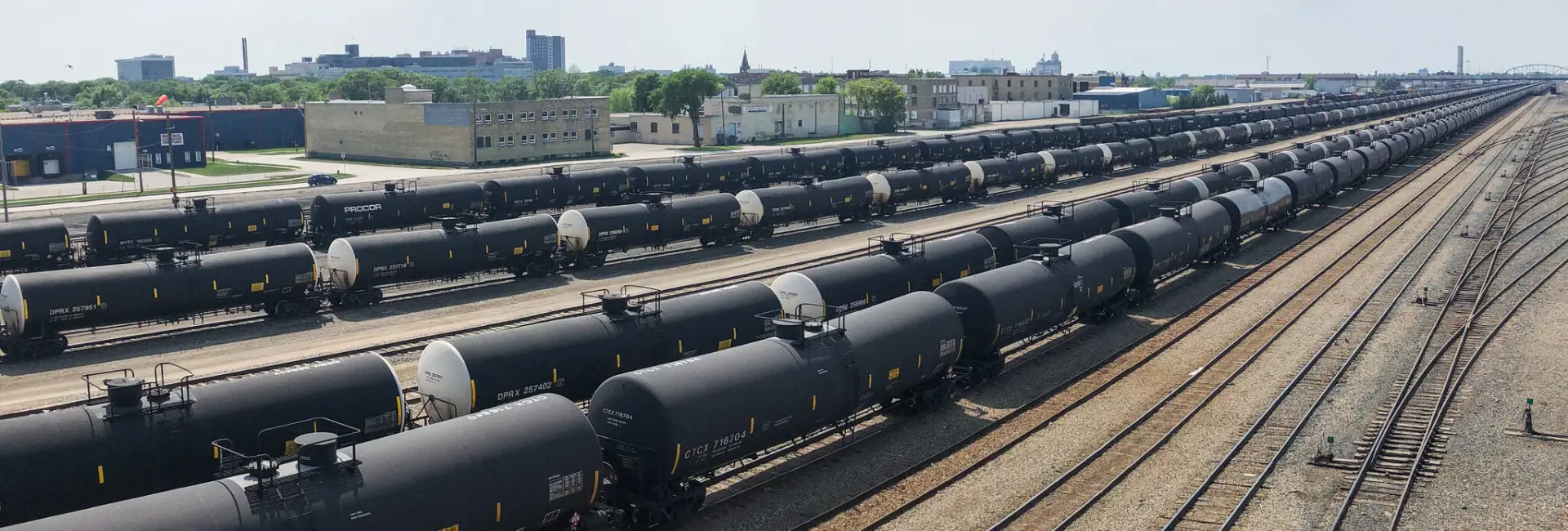It’s time for Winnipeg to seize a bold new opportunity
May 20, 2025
By Brent Bellamy, Associate + Creative Director
Originally published in the Winnipeg Free Press
“It is time to build things that we never imagined, and to build them at a speed that we have never seen. It is a time to be bold, to meet this crisis with overwhelming positive force.”
These are the words of Prime Minister Mark Carney, asking Canadians to come together to fundamentally reimagine our economy, and our country, in response to a changed relationship with the United States.
Carney has challenged provincial premiers to come forward with nation-building ideas that focus on productivity, competitiveness, economic growth, employment, environmental sustainability, and quality of life.

Looking at the rail lands, and seeing a bright future.
Early ideas have focused on increasing natural resource extraction and expediting its transportation to market, with the development of a coast-to-coast, national trade and energy corridor, grabbing headlines.
Just as it was 140 years ago when the transcontinental railway became Canada’s first nation-building project, Winnipeg’s strategic gateway location along such a corridor, uniquely positions the city to boldly push its way to the front of the line and seize a generational opportunity to play a central role in a national movement to “build, baby, build.”
The railways will likely play a vital role in a national trade corridor, but their current configuration, slowly snaking through the downtown and residential neighbourhoods of a major Canadian city, is contrary to the vision of a future-focused transportation corridor.
In trade, speed is money, meaning no railway company would ever choose to operate in the centre of a city. Conversely, no city would choose to forever incur the cost of infrastructure, like replacing Arlington Bridge, to overcome the conflicts of having railways at its centre. Despite this, the idea of rail relocation in Winnipeg has long been considered a dream too big to imagine, but in this moment, we have been specifically challenged to build things we have never imagined.
New trade corridors will be vital for the country’s prosperity, but redefining our national economy requires thinking beyond pulling more things out of the ground and getting them to market faster.
The economy of the future will fundamentally be about people, and cities, the true economic drivers of our country. A cohesive strategy from Winnipeg could address both national and local economic priorities, beginning with optimizing rail operations to facilitate greater interprovincial trade and position the industry for future innovation and technological evolution, while leveraging this fundamental move to create radical local transformation in our city.
The federal government has announced that they will create a new Crown corporation called Build Canada Homes, which will develop affordable housing across the country.
Relocating railyards in Winnipeg would make land available for this new body to implement affordable, residential development on a large and transformational scale. A medium-density, mixed-use neighbourhood on the CPR yards could accommodate enough people to be the third-largest city in the province. Redeveloping the BNSF yards in River Heights could increase the population of that neighbourhood by one-third.
These types of large-scale infill neighbourhoods would allow the city to grow in a more economically and environmentally sustainable way, reducing the amount of new infrastructure and services required to accommodate population growth. Massive new construction employment would be created to both relocate railways and construct new infill neighbourhoods in their place.
This would attract new investment and economic activity to mature communities, grow the city’s tax base, and provide affordable housing and social opportunity for new families. The province could bolster this strategy by incorporating its own surplus land into the initiative, including its seven downtown surface parking lots.
Redeveloping the spider’s web of rail lines across Winnipeg provides a different opportunity to introduce a network of mobility corridors that create a new layer of connectivity between Winnipeg neighbourhoods.
These corridors could include green space, walking trails, and cycling freeways that connect suburban neighbourhoods to the inner city. Rail bridges could be turned into bike/walk bridges that unite communities through active transportation, growing neighbourhood economies by reducing pedestrian distances and expanding the potential market for local shops, restaurants and services. New bike/walk bridges could be introduced to supplement the network, including the long-planned Osborne to Downtown Walk Bike Bridge through redeveloped McFadyen and Fort Rouge Parks. This new web of active mobility could transform how we move around our city, increasing economic opportunity, neighbourhood vibrancy and quality of life.
Mobility corridors could also facilitate the long overdue implementation of a connected rapid transit network. Winnipeg will soon be the only city in the country’s 10 largest without light rail transit.
New mobility corridors could expedite this and be the catalyst to move more quickly on other rapid transit initiatives, most importantly the downtown connections that will create major multi-modal hubs at Union Station and Portage and Main, igniting much-needed urban renewal in the city centre. Cities across the continent have demonstrated the power that rapid transit, particularly light rail, has in attracting higher density housing and neighbourhood investment through transit-oriented development, while providing new mobility options for citizens to access employment, education, and recreation.
Canada is facing a defining moment in its history.
The prime minister has made it clear that the federal government is looking to rewire our economy, and redefine our strategies on climate change, housing, and productivity.
All cities will be central to these goals, and Winnipeg is uniquely positioned to lead with a cohesive proposal that begins with the larger goal of removing friction from international and provincial trade through rail relocation and optimization, and continues by being locally transformative, creating far-reaching, radical change, building a more sustainable, prosperous, and economically resilient city, with a higher quality of life for all.
The door of opportunity has been opened; we should boldly walk through.

